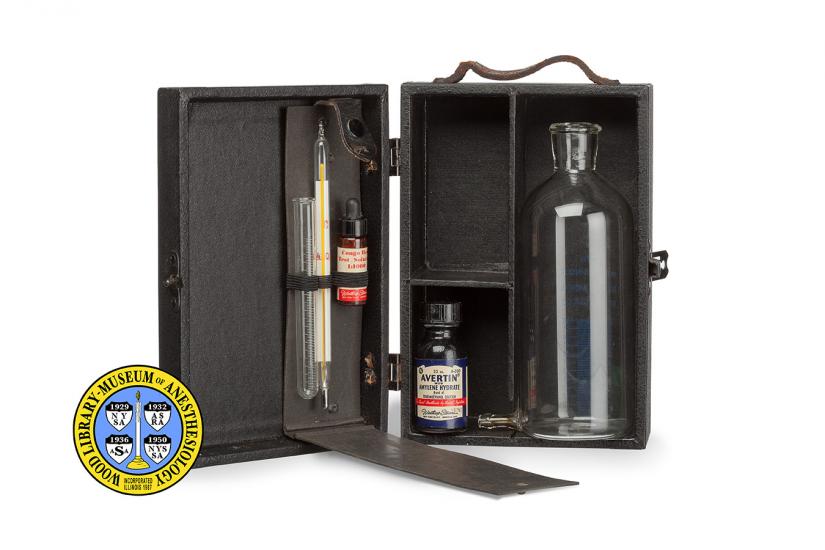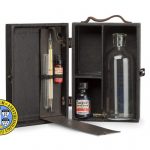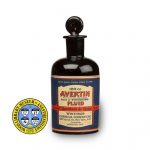Avertin Kit
The hypnotic drug, tribromethanol was first described in 1923 by German chemists Richard Willstäter (1872-1942) and Carl Duisberg (1861-1935). It was introduced for the then-new technique of basal anesthesia in 1926 by the German pharmacologist, Fritz Eichholtz (1889-1967). The technique of basal anesthesia used premedication to depress the patient's central nervous system, reducing the amount of inhalation anesthetic required for the surgery. Avertin, made by Winthrop Chemical Company, combined tribromethanol with another hypnotic drug, amylene hydrate. It was administered rectally, half an hour before the operation.
Dr. Paul Wood (1894-1963) was an advocate for the basal technique, and this agent. He designed his Avertin apparatus in the mid-1930s. It was made by The Foregger Company. The kit included a flask for mixing the drug with warm water to the required dosage, which was calculated according to the patient's body weight, a test tube for pouring the drug into the flask, a thermometer to ensure that the water was of the right temperature, and a rubber tube. The Avertin itself, and a testing agent to determine the purity of the mixture, had to be purchased separately.
Catalog Record: Avertin Kit
Access Key: aknn
Accession No.: 2010-08-31-1
Title: [Avertin Kit / Paul M. Wood.]
Author: Wood, Paul M. (Meyer), 1894-1963.
Corporate Author: Foregger Company.
Publisher: [New York] : [The Foregger Company, Inc.], [1936-1960].
Physical Descript: 1 medication kit ; wood, vinyl, glass, metal, leather ; 25 x 16.5 x 9 cm.
Subject: Tribromoethanol.
Subject: Anesthesia, Rectal instrumentation.
Subject: Deep Sedation – history.
Web Link: https://woodlibrarymuseum.org/museum/item/649/avertin-kit
Note Type: General
Notes: Date range for the possible year of manufacture is based around the earliest
and latest Foregger Company catalogs in which the Avertin Kit was found (1937
and 1959). The date range could change if documentation indicates the range
should be corrected.
Note Type: General
Notes: Title taken from the 1937 Foregger Company catalog (#7). The title could
change if new documentation that indicates that the dates should be corrected
Note Type: Citation
Notes: Avertin Kit. Catalog No. 7. Roslyn, New York: The Foregger Company, Inc.;
1937:76.
Note Type: Citation
Notes: Avertin Kit. Catalog no. 15. Roslyn Heights, New York: The Foregger Company,
Inc.; 1959:142.
Note Type: Citation
Notes: Ball C, Westhorpe R. Induction agents: “Avertin”. Anaesth Intensive Care.
2001;29(6):571.
Note Type: Citation
Notes: Bickley RS, Wood PM. Observations on the use of tribromoethanol (Avertin). Am
J Surg. December, 1936:34(3):598-605.
Note Type: Citation
Notes: Dwyer CS, Strout WG, Thomas PB. Intravenous avertin anesthesia.
Anesthesiology. 1953 May;14(3):245-254.
Note Type: Citation
Notes: Fifty-eight years ago in Anesthesia & Analgesia: B. Bolliger, K. Maddox.
Experimental anesthesia with tri-bromethyl alcohol (Avertin) and sodium
iso-amyl-ethyl-barbiturate (Amytal). … 1931;10:112-115. Anesth Analg.
1989;68(4):540.
Note Type: Citation
Notes: Goerig M. The Avertin story. In: Fink BR, ed. The History of Anesthesia:
Third International Symposium. Park Ridge, IL: Wood Library-Museum of
Anesthesiology; 1992:223-232.
Note Type: Citation
Notes: Kreiselman J. Avertin anaesthesia from the anaesthetist’s standpoint: a
resume of eighteen months experience. Ann Surg. 1931 November; 94(5): 885–887
Note Type: Citation
Notes: Lindskog GE, Spicer AD. Lung volume under surgical anaesthesia: the effect of
Avertin on the subtidal air. J Clin Invest. 1941;20(4):355-359.
Note Type: Citation
Notes: Stehle RL. Avertin Anaesthesia. Can Med Assoc J. 1928 Dec;19(6):706-707.
Note Type: Physical Description
Notes: One wooden case covered in a leather-textured vinyl; The case has two hinges,
one latched and a leather carrying handle; No manufacturer’s marks are on the
case.; Inside the case is a space for a glass flask for administering the
Avertin rectally; On the same side of the case as the flask, here are also
spaces for Vaseline, and a bottle of Avertin; The flask measures 20 cm in
height and is marked up to 220 “LBS.” of BODY WT.” on one side, and 6.0
“FLUID C.C.” on the other; Markings above the graduation include, “AVERTIN
[new line] WOOD TECHNIQUE”; At the base of the flask is a port for connecting
a rectal tube; The bottle of Avertin is dark amber, with a black lid, and
measures approximately 8.5 cm in height and 3.5 diameter; Text on the
bottle’s label includes “25 cc.[new line] AVERTIN [new line] AMYLENE HYDRATE
[new line] Brand of [new line] TRIBROMOETHANOL SOLUTION [new line] For Basal
Anesthesia by Rectal Injection [new line] Winthrop Stearns, Inc. [new line]
NEW YORK 18, N.Y. WINDSOR, ONT.”; On the left side of the label is printed,
“KEEP AWAY FROM OPEN FLAME. [new line] Avertin with Amylene Hydrate should
always be injected slowly (not less than 5 to 10 minutes) [new line] Each 1
cc. contains 1 Gm. Avertin and 0.5 Gm. amylene hydrate.”; On the right side
of the label the following is printed, “Caution: Federal law prohibits
dispensing without precision. [new line] Read accompanying circular. [new
line] Avertin, trademark reg. U.S. & Canada [new line] MADE IN U.S.A.”; On
the other side of the case is a place to hold a graduated test tube, a simple
thermometer with one marking for 40 degrees Celsius, and a bottle of Congo
Red Test Solution; The test tube is graduated in 1/10 of ml markings up to 10
ml’s.
Note Type: Reproduction
Notes: Photographed by Mr. Steve Donisch, June 11, 2013.
Note Type: Acquisition
Notes: This acquisition was made in memory of David Lawrence Morris by his mother,
Betty C. Morris.
Note Type: Historical
Notes: This partitioned case contained the equipment needed to prepare and
administer the anesthetic tribromethanol, brand name Avertin. Introduced in
the U.S. in the early 1930s, it marked a significant advance in anesthetics.
Avertin had a calming effect and did not cause post-operative nausea and
vomiting like ether, so some patients preferred it. Anesthesiologists also
liked it because it was non-flammable. Avertin was typically administered by
enema. If given intravenously it could cause damage to veins and other
tissues.
Avertin was developed and first used as an anesthetic in Germany during the
1920s. Anesthesiologist, Paul M. Wood, MD used the new drug and designed this
kit to streamline its administration. It was manufactured by The Foregger
Company of New York.
Preparing Avertin involved calculating the dose based on the patient’s weight
and properly diluting the dose with distilled water in a glass flask, which
would be attached to tubing for rectal administration. The distilled water
needed to be at a specific temperature before the Avertin was added, and the
pH of the resulting solution had to be checked before it was administered to
the patient.
Although used into the 1960s, Avertin was especially popular during the 1930s
and 1940s. It was primarily used to induce, or start, anesthesia, and augment
other anesthetics, inhalation as well as regional. It was also used alone for
short surgical procedures. Yet, with potential side effects such as
significantly diminished blood pressure and breathing, Avertin, was not the
perfect anesthetic and it was slowly replaced by safer options.
Note Type: Publication
Notes: Boyd J. Benzadrine sulphate: its use to interrupt Avertin anaesthesia. Br Med
J. May 4, 1940;1(4139):729-730.
Note Type: Publication
Notes: Schrier RI. Tribromethanol (Avertin). Clin Anesth. 1963;1:121-129.
Note Type: Publication
Notes: Wood PM. Clinical use of cyclopropane and tribromethanol in amylene hydrate.
JAMA. January 25, 1936;106(4):275-279.
Note Type: Exhibition
Notes: Chosen for the WLM website (noted November 26, 2013).



